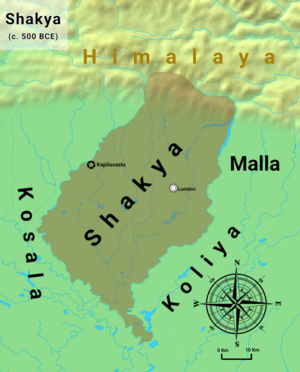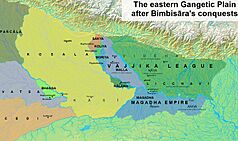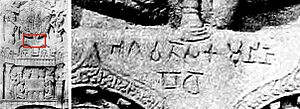Shakya facts for kids
Quick facts for kids
Shakya Republic
|
|||||||||
|---|---|---|---|---|---|---|---|---|---|
| c. 7th century BCE–c. 5th century BCE | |||||||||
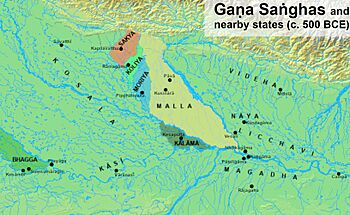
Shakya among the Gaṇasaṅghas
|
|||||||||
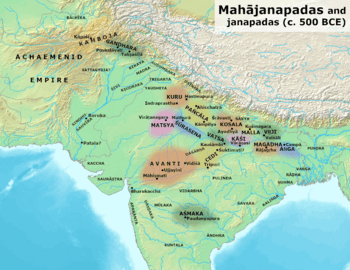
Shakya to the north of the Mahajanapadas in the post-Vedic period
|
|||||||||
| Capital | Kapilavastu | ||||||||
| Common languages | Prakrits Munda languages |
||||||||
| Religion | Sramana religions, Sun worship, tree worship, serpent worship | ||||||||
| Government | Republic | ||||||||
| Historical era | Iron Age | ||||||||
|
• Established
|
c. 7th century BCE | ||||||||
|
• Conquered by Viḍūḍabha of Kosala
|
c. 5th century BCE | ||||||||
|
|||||||||
| Today part of | India Nepal |
||||||||
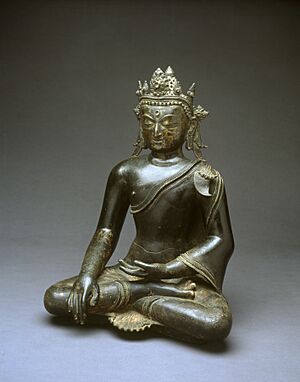
The Shakya (also spelled Sakya) were an ancient group of people who lived in the northeastern part of South Asia during the Iron Age. They were organized as a Shakya Republic, which was a type of government where a group of important families (an oligarchy) made decisions, rather than a single king. This kind of government was called a gaṇasaṅgha. The Shakyas lived on the edge of the eastern Indo-Gangetic Plain, in a cultural area known as Greater Magadha.
Contents
Where Did the Shakyas Live?
The Shakyas lived in the Terai region. This area is south of the Himalayas mountains and north of the wide Indo-Gangetic Plain. Their neighbors to the west and south were the powerful kingdom of Kosala. To their east, across the Rohni River, lived the Koliya tribe, who were related to the Shakyas. To the northeast, they shared a border with the Mallakas of Kushinagar. North of the Shakya territory, the land stretched into the forested parts of the Himalayas.
The main city and capital of the Shakyas was Kapilavastu.
What Does the Name "Shakya" Mean?
The name Shakya comes from the Sanskrit word śak, which means "to be able," "worthy," or "possible."
It might also come from the name of the śaka or sāka tree. This tree is thought to be either the teak or sāla tree. The name is also linked to the word śākhā, meaning 'branch.' This connection suggests that the Shakyas may have worshipped the śaka or sāka tree.
History of the Shakyas
How the Shakyas Began
The Shakyas were a group of people from the eastern sub-Himalayan region. They were on the edge of the eastern Gangetic plain, in a cultural area called Greater Magadha. The Shakyas were a mix of Indo-Aryan and Munda people. The Indo-Aryan group was a smaller part of their population. The Shakyas were closely connected to their eastern neighbors, the Koliya tribe, and often married into their families.
The Shakya Republic
By the 6th century BCE, the Shakyas, along with the Koliyas, Moriyas, and Mallakas, lived between the powerful kingdoms of Kosala to the west and the Licchavikas and Vaidehas to the east. At this time, the Shakya Republic became a smaller state under the larger Kingdom of Kosala.
During the 5th century BCE, one of the leaders of the Shakya ruling families was Suddhodana. He was married to Princess Māyā, who was the daughter of a Koliya noble. Their son was Siddhartha Gautama, who later became known as the Buddha and founded Buddhism.
While the Buddha was alive, the Shakyas and the Koliyas had a fight over the water from the Rohiṇī river. This river was the border between their lands, and both tribes needed its water for their crops. The Buddha stepped in and helped them stop fighting.
After the Buddha passed away, the Shakyas asked for a share of his relics (sacred remains) from the Mallakas of Kusinārā. They believed they had a right to them because the Buddha was a Shakya.
Conquest by Kosala
Soon after the Buddha's death, King Viḍūḍabha of Kauśalya attacked the Shakya and Koliya republics. He had taken over his father's kingdom and wanted to conquer their lands because they had once been part of Kosala. Viḍūḍabha eventually won the war against the Shakyas and Koliyas. This war caused many lives to be lost on both sides.
After being conquered, the Shakyas and Koliyas lost their political power. They became part of Kosala's population. Most Shakyas soon blended into Kosala, with only a few families keeping their Shakya identity. The Koliyas also disappeared as a separate group.
The war with the Shakyas and Koliyas weakened Kosala. Because of this, Kosala itself was soon taken over by its eastern neighbor, the kingdom of Magadha. King Viḍūḍabha of Kosala was defeated and killed by King Ajātasattu of Magadha.
Legacy of the Shakyas

In Buddhism
The Buddha was called the "Sage of the Shakyas" by his followers. This name is Sakka-muni in Pali and Śākya-muni in Sanskrit.
Even the way things work in the Trāyastriṃśa heaven (a heavenly realm in Buddhist cosmology) is based on how the Shakya assembly hall (called a santhāgāra) operated.
Modern Claims of Shakya Descent
Some groups today claim to be descendants of the Shakyas. The Tharu people in the Terai region of India and Nepal say they are from the Shakya line. Many Newars in the Kathmandu valley in Nepal also use the surname Shakya and believe they are descendants of the Shakya clan. They sometimes used titles like Śākyavamsa, meaning "of the Shakya lineage."
According to an old Burmese history book called Hmannan Yazawin, a legendary king named Abhiyaza founded the Tagaung Kingdom in Burma. This book says he belonged to the same Shakya clan as the Buddha. He supposedly moved to Burma after the Shakya kingdom was conquered by Kosala.
Shakya Culture and Society
Social Structure
The Shakyas lived in the Greater Magadha cultural area. Their customs were different from the traditional Vedic (ancient Indian) ways. Unlike the Vedic system, the Shakyas did not follow the caturvarṇa social system, which had four main classes: Brahmins, Kshatriyas, Vaishyas, and Shudras.
Instead, Shakya society had an aristocratic class of khattiyas (nobles) and a class of servants or slaves called suddas. The khattiyas were considered higher in their society.
Language
The Shakyas spoke at least two languages. They were influenced by Munda languages. Many of their village names were Mundari. Even the name of their clan's founder, Ikṣvāku (in Sanskrit) or Okkāka (in Pali), came from a Munda origin.
How the Shakya Government Worked
The Shakyas were organized as a gaṇasaṅgha, which was an aristocratic republic. This was similar to how the Licchavikas governed themselves.
The Assembly
The leaders of the Shakya khattiya (noble) families formed an Assembly. These leaders were called rājās. The position of rājā was passed down from father to eldest son. The eldest son, while his father was alive, was called uparājā (Viceroy).
The Shakya Assembly met in a hall called a santhāgāra. The main one was in Kapilavastu, but there was at least one other. The Assembly discussed important public matters like war, peace, and alliances. They had a simple voting system, either by raising hands or using wooden chips.
The Council
The full Assembly did not meet very often. Instead, a smaller group called the Council met more regularly to run the republic. The members of this Council were called amaccās. They were in charge of the republic's daily affairs.
The Mahārājā (Consul)
The leader of the Shakya republic was an elected chief. This person was like a "first among equals," similar to Roman consuls or Greek archons. This leader was called the mahārājā. The mahārājā managed the republic with the help of the Council.
When the Assembly met, the rājās gathered in the santhāgāra. Four amaccās stood in the corners to hear the speeches clearly. The mahārājā would take his seat and present the topics for discussion. Members would share their views, which the four amaccās would record. After the meeting, the recorders compared their notes, and the amaccās would decide.
Shakya Lifestyle
Marriage Customs
The Shakya ruling families sometimes practiced sibling marriages. This was not allowed among Vedic peoples. It was a way for these families to keep power within a smaller group of the Shakya clan. This practice was not permitted for the lower classes.
Religion and Beliefs
Since they lived in the Greater Magadha area, the Shakyas followed religious customs that were different from the traditional Brahmanical (Vedic) religion. Even during the Buddha's time, Brahmanism was not the main religion or culture in the Greater Magadha region.
This was a place where Śramaṇa movements (groups of wandering spiritual seekers) existed. One of these movements, Buddhism, was founded by Siddhartha Gautama, who was a Shakya.
Sun Worship
The Shakyas worshipped the Sun-god, believing he was their ancestor. This is why the Shakya khattiya (noble) clan claimed to be from the Ādicca (Sun) gotta (clan) and the Sūryavaṃśa ("Solar dynasty").
Origin Story
The Shakya khattiya clan had a story about their origins. They claimed to be descended from the Sun-god through his descendant, named Okkāka (in Pali) or Ikṣvāku (in Sanskrit). This story said that Okkāka's eight pairs of twin sons and daughters married each other and founded the Shakya capital city. They were believed to be the ancestors of the tribe.
This story helped explain why the ruling Shakya families had the right to be in the santhāgāra (assembly hall). These families were often related and owned land next to each other, which helped establish their power.
Tree Worship
The importance of the Sāl tree in the Buddha's life, and his enlightenment under a Bodhi tree, suggests that the Shakyas worshipped trees. This custom likely came from Munda religious practices of worshipping sacred groves. The Sāl tree was very important in their traditions; its flowering marked the beginning of their New Year and Flower Feast festivals. For example, the Santal tribe worships the Sāl tree and holds communal meetings under them.
The worship of tree spirits called yakkhas and yakkhīs was common in the Greater Magadha region. This practice was older than the Indo-Aryan traditions.
Serpent Worship
The nāga (serpent) king Mucalinda is said to have protected the Buddha during a storm. Mucalinda was both a snake and a tree deity. This suggests that the Shakyas also worshipped serpents. This practice likely came from the pre-Indo-Aryan people of northern South Asia.
Funeral Customs
The Shakyas' cremation rituals for the Buddha's funeral involved wrapping his body in many layers of cloth. It was placed in an iron pot filled with oil, then covered with another iron pot before being cremated. These rituals, like honoring the body with singing, dancing, and music, and burying his bones in a round stūpa (mound) with flags and parasols at a public crossroads, came from the pre-Indo-Aryan people of the eastern Gangetic plains. These were rituals performed for their great rulers.
See also
- Shakya (surname)
Sources


